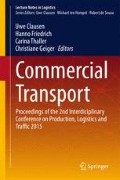Abstract
This work was created as part of the research project SEAK, which looks into possible causes and consequences of food shortfalls in Germany and is moreover also aimed at developing and evaluating possible mitigation strategies for these shortfalls. For the management of shortfalls in food supply it would be, as a first step, crucial to have information on existing inventories. Making for example decisions on the reallocation of food products into regions affected by disasters is only possible if knowledge about the (regional) availability of food quantities is present in the first place. This could be considered as a necessary transparency. However, in the German food sector, it is hard to get data about the inventories kept by companies like producers, logistic service providers (LSP’s), wholesalers or retailers. This is due to the fact that usually companies are not obliged to publish this information. Moreover, this information is also considered confidential in most companies, since it would give competitors insight into their business model and processes, which are oftentimes the basis for their success. Since information concerning food inventories is not publicly available, it has to be derived in another manner. This work is aimed at providing a scientific basis for the modelling of inventories along food supply chains. More specifically, it does so for the food commodity group of dairy products. We gathered information on all available food products, but limit this particular analysis to dairy products as a showcase of our approach. First, we introduce the data set used for the analysis and the methodology applied to it. In a next step, characteristics of typical German dairy supply chains are described using practical evidence as well as literature findings. The description follows the supply chain’s structure from start to finish, downstream. In the end, concluding remarks are made and possible further research ventures are suggested.
Access this chapter
Tax calculation will be finalised at checkout
Purchases are for personal use only
Preview
Unable to display preview. Download preview PDF.
References
Broekmeulen R, van Donselaar K (2009) A heuristic to manage perishable inventory with batch ordering, positive lead-times and time-varying demand. Comput Oper Res 36:3013–3018
van Donselaar K, van Woensel T, Broekmeulen R, Fransoo J (2006) Inventory control of perishables in supermarkets. Int J Prod Econ 104:462–472
Flick U, von Kardorff E, Steinke I (2013) Qualitative Forschung – Ein Handbuch“, 10. Auflage, rowohlt Verlag
Gläser J, Laudel G (2010) Experteninterviews und qualitative Inhaltsanalyse, 4. Auflage, VS Verlag
Kahn BE, Schmittlein DC (1989) Shopping trip behavior: an empirical investigation. Market Lett 1(1):55–69
Kotzab H, Teller C (2005) Development and empirical test of a grocery retail instore logistics model. Br Food J 107(8):594–605
Kuhn H, Sternbeck M (2011) Logistik im Lebensmittelhandel : eine empirische Untersuchung zur Ausgestaltung handelsinterner Liefernetzwerke. Kath. University, Ingolstadt
Mayring P (2011) Qualitative Inhaltsanalyse: Grundlagen und Techniken, 11. Auflage, Beltz Pädagogik
Peilnsteiner J, Truszkiewitz G (2002) Handbuch Temperaturgeführte Logistik. Behr’s Verlag
Smaros J, Angerer A, Fernie J, Toktay B, Zotteri G (2004) Logistics processes of European grocery retailers, insead working paper series
Thron T, Nagy G, Wassan N (2007) Evaluating alternative supply chain structures for perishable products. Int J Logist Manag 18(3):364–384
Author information
Authors and Affiliations
Corresponding author
Editor information
Editors and Affiliations
Appendix
Appendix

Rights and permissions
Copyright information
© 2016 Springer International Publishing Switzerland
About this paper
Cite this paper
Hansen, O., Friedrich, H. (2016). An Inventory-Focused Analysis of German Food Supply Chains: The Case of Dairy Products. In: Clausen, U., Friedrich, H., Thaller, C., Geiger, C. (eds) Commercial Transport. Lecture Notes in Logistics. Springer, Cham. https://doi.org/10.1007/978-3-319-21266-1_22
Download citation
DOI: https://doi.org/10.1007/978-3-319-21266-1_22
Published:
Publisher Name: Springer, Cham
Print ISBN: 978-3-319-21265-4
Online ISBN: 978-3-319-21266-1
eBook Packages: EngineeringEngineering (R0)

